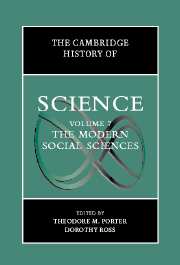Book contents
- Frontmatter
- 1 Introduction: Writing the History of Social Science
- PART I SCIENCES OF THE SOCIAL TO THE LATE NINETEENTH CENTURY
- PART II THE DISCIPLINES IN WESTERN EUROPE AND NORTH AMERICA SINCE ABOUT 1880
- PART III THE INTERNATIONALIZATION OF THE SOCIAL SCIENCES
- PART IV SOCIAL SCIENCE AS DISCOURSE AND PRACTICE IN PUBLIC AND PRIVATE LIFE
- 30 The Uses of the Social Sciences
- 31 Managing the Economy
- 32 Management and Accounting
- 33 Polling in Politics and Industry
- 34 Social Science and Social Planning During the Twentieth Century
- 35 Social Welfare
- 36 Education
- 37 The Culture of Intelligence
- 38 Psychologism and the Child
- 39 Psychiatry
- 40 Gender
- 41 Race and The Social Sciences
- 42 Cultural Relativism
- 43 Modernization
- Index
- References
39 - Psychiatry
from PART IV - SOCIAL SCIENCE AS DISCOURSE AND PRACTICE IN PUBLIC AND PRIVATE LIFE
Published online by Cambridge University Press: 28 March 2008
- Frontmatter
- 1 Introduction: Writing the History of Social Science
- PART I SCIENCES OF THE SOCIAL TO THE LATE NINETEENTH CENTURY
- PART II THE DISCIPLINES IN WESTERN EUROPE AND NORTH AMERICA SINCE ABOUT 1880
- PART III THE INTERNATIONALIZATION OF THE SOCIAL SCIENCES
- PART IV SOCIAL SCIENCE AS DISCOURSE AND PRACTICE IN PUBLIC AND PRIVATE LIFE
- 30 The Uses of the Social Sciences
- 31 Managing the Economy
- 32 Management and Accounting
- 33 Polling in Politics and Industry
- 34 Social Science and Social Planning During the Twentieth Century
- 35 Social Welfare
- 36 Education
- 37 The Culture of Intelligence
- 38 Psychologism and the Child
- 39 Psychiatry
- 40 Gender
- 41 Race and The Social Sciences
- 42 Cultural Relativism
- 43 Modernization
- Index
- References
Summary
Psychiatry, a branch of medicine, is a discipline that historically has taken severe mental illness as its object. In the course of the twentieth century, it dramatically expanded its purview, bringing the full range of human behaviors, both normal and pathological, within its domain. By the end of the century, psychiatry dealt with problems in everyday living as well as with schizophrenia and depression. It had become, as psychiatrists sometimes put it, “as broad as life.” In the process, it had also moved into the domain of the social and behavioral sciences. This essay will examine that expansion, focusing primarily on American psychiatry.
Unstably situated between genetics and biology on the one hand and the behavioral sciences – psychology, sociology, anthropology – on the other, psychiatry uniquely bridges medicine and the disciplines. Its practitioners take into account “everything from the molecular level to the most basic social issues.” They disagree, sometimes vehemently, on its goals, practices, and fundamental truths. Equally important to its instability, psychiatry has been thoroughly remade during the twentieth century. This remaking has fostered an eclecticism that is often interpreted as fragmentation, with psychiatrists advocating a broad range of conflicting models of behavior and disease. The remaking has also fostered a curious relationship between psychiatrists and their discipline’s history, with some taking pride in its ancient roots and others willing to jettison them and proclaim their discipline altogether new. “What is psychiatry?” has seemed to many a pressing question throughout the twentieth century.
- Type
- Chapter
- Information
- The Cambridge History of Science , pp. 663 - 677Publisher: Cambridge University PressPrint publication year: 2003
References
- 2
- Cited by



